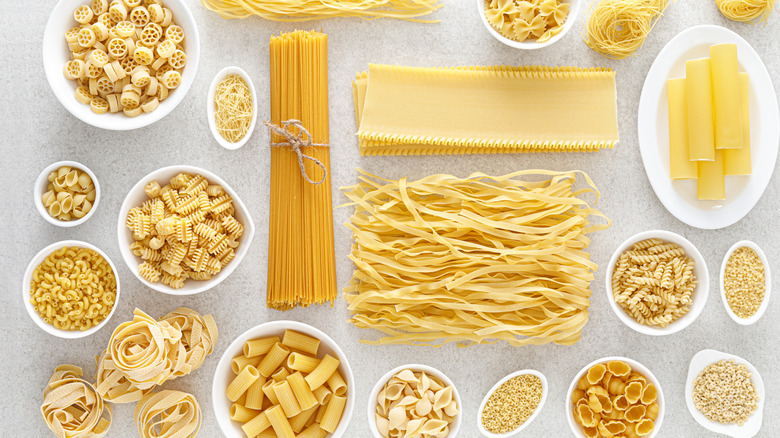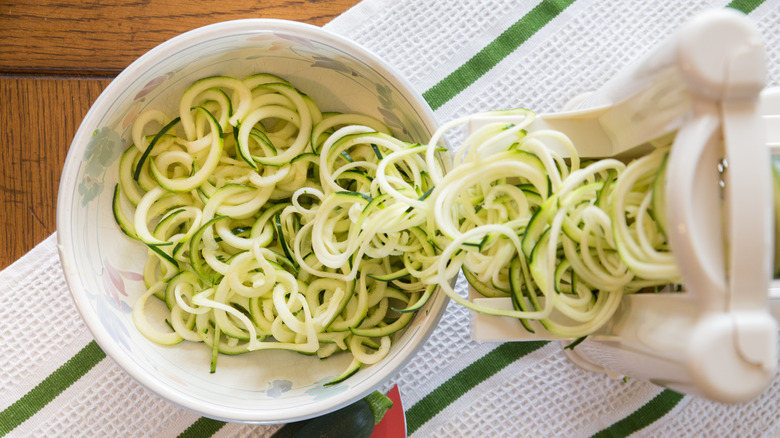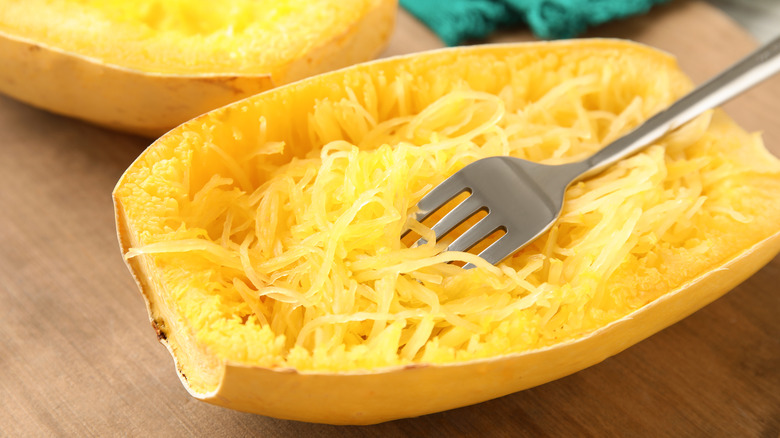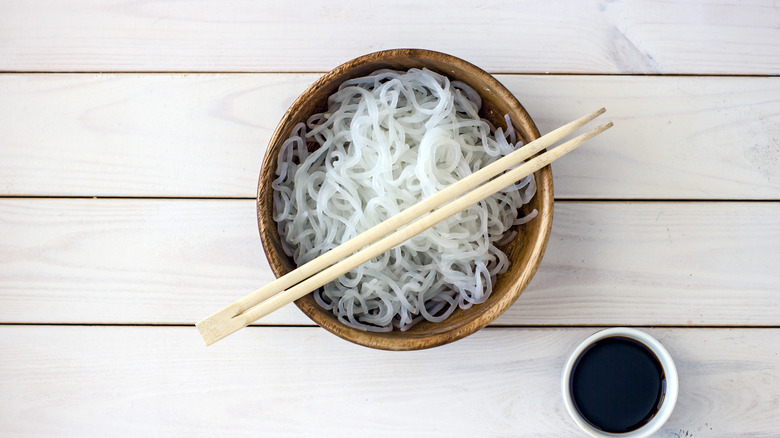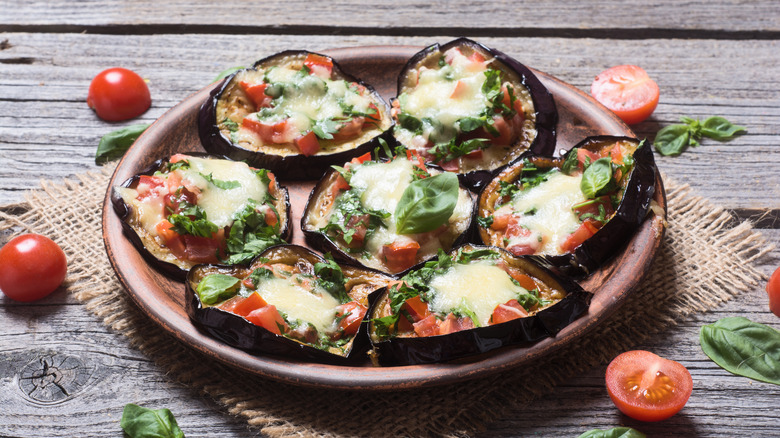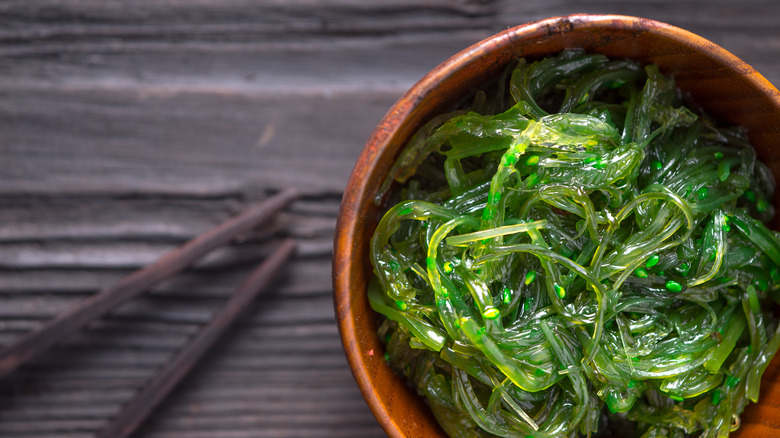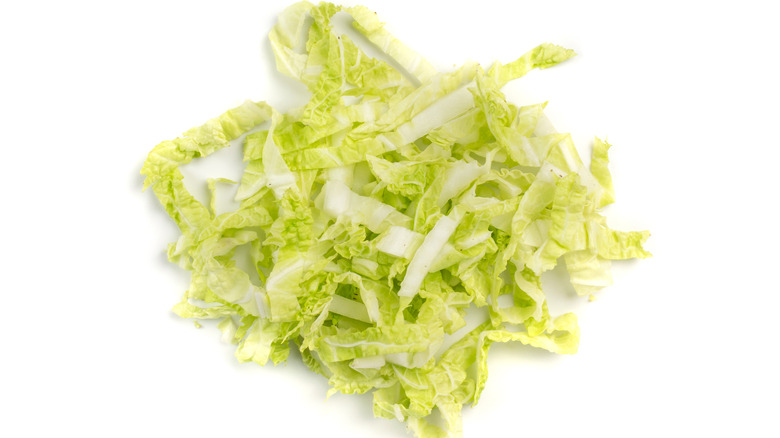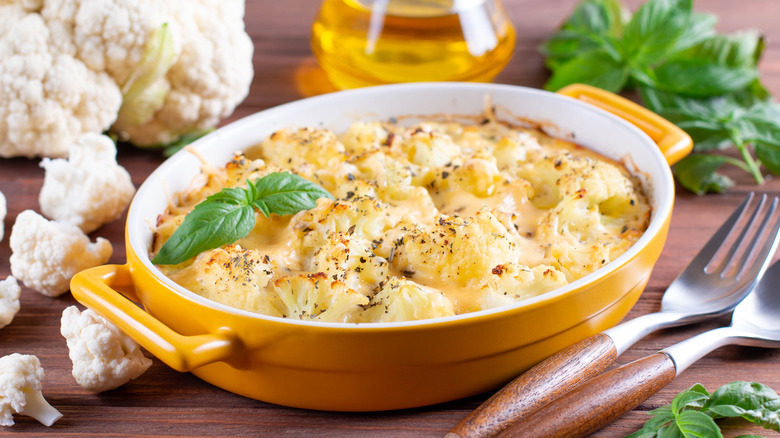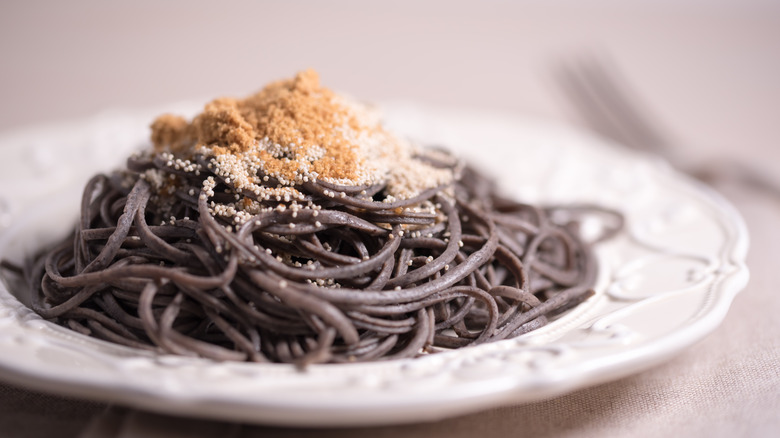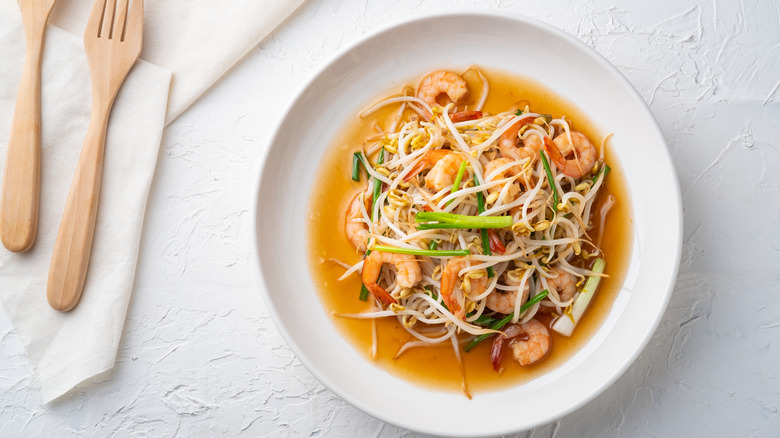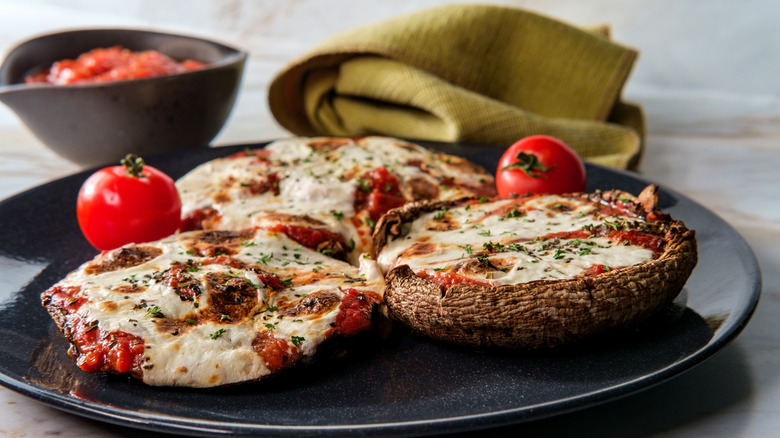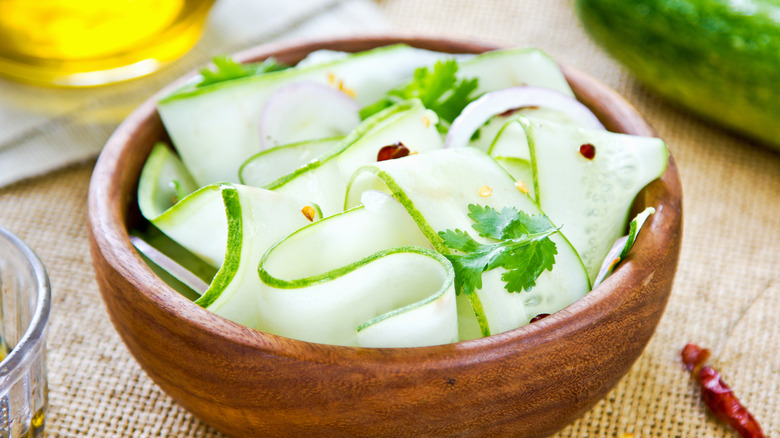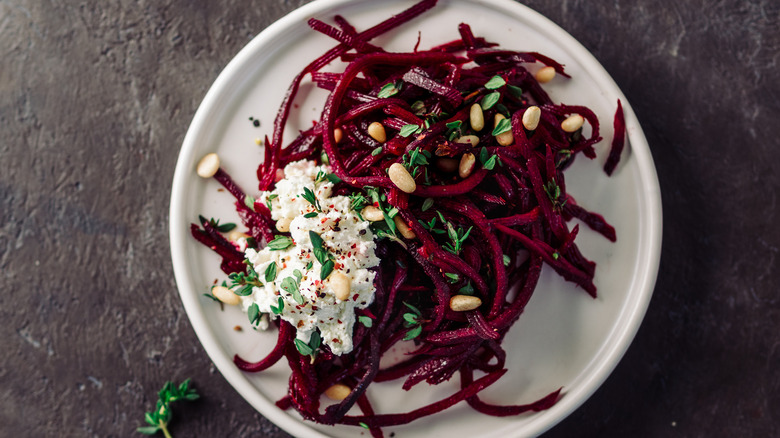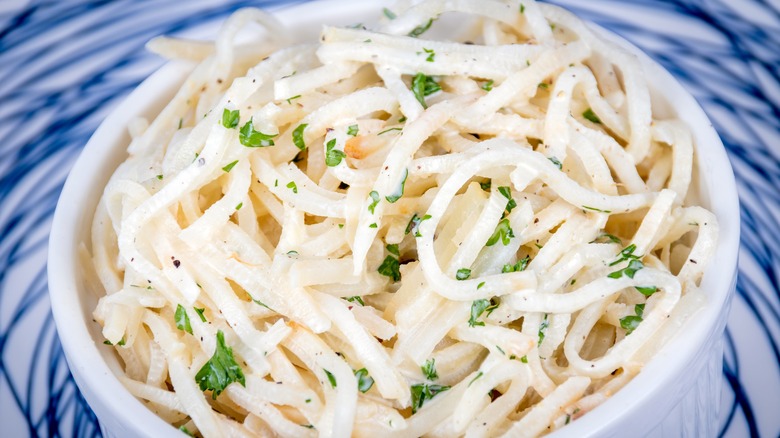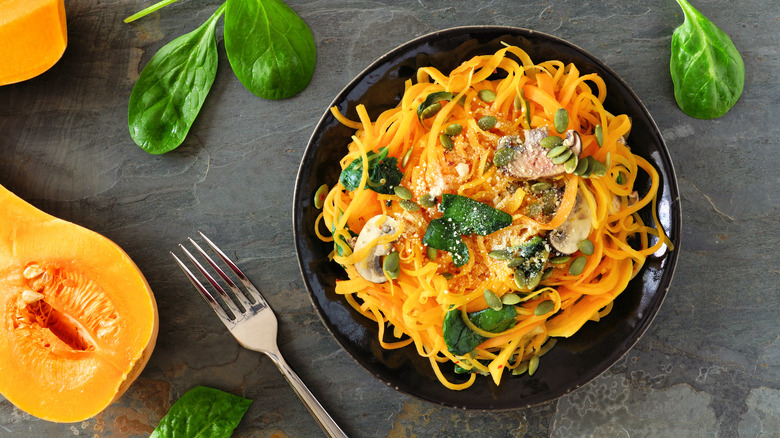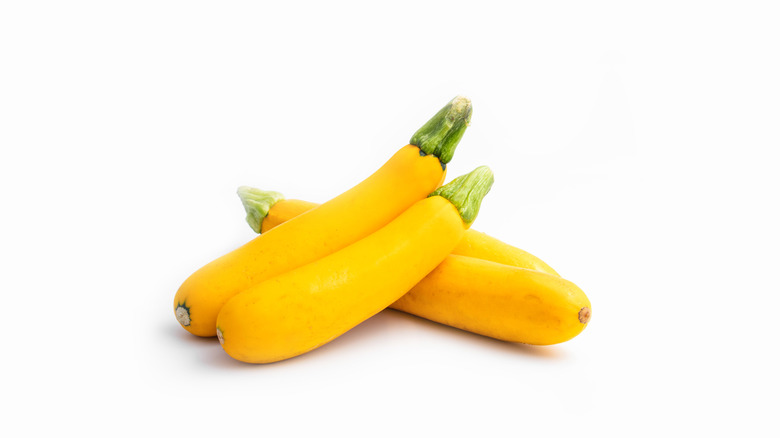16 Low-Carb Alternatives To Pasta And Noodles
Many people looking for ways to eat healthier and lose weight have joined the low-carb club. According to ScienceDaily, low-carb diets are an effective way to shed unwanted pounds. Besides aiding weight loss, there are other great reasons to follow a low-carb diet. According to Healthline, eating a diet low in carbohydrates reduces visceral fat (belly fat), which is linked to several serious health issues. In addition, low-carb diets can help reduce bad cholesterol and increase good cholesterol. With so many great health benefits, adopting a low-carb diet is an excellent way to maintain a healthy lifestyle.
Of course, changing your regular diet to a low-carb diet requires making some changes to your weekly menu. You will need to find low-carb meal options and substitutes. For example, you can swap burger buns and taco shells for lettuce wraps and use cauliflower for just about everything from potatoes to rice to pizza crust. But the real challenge is replacing high-carb foods like pasta and noodles. Luckily for low-carb dieters, other vegetables can replace pasta and noodles without losing that all-important component — the flavor.
Zucchini
Zucchini noodles, or zoodles, are a great alternative to pasta. With just 33 calories and 6.9 grams of carbs per medium zucchini, you can enjoy extra plates of zoodles (via Calorie King). Zoodles are firm enough to hold your favorite pasta sauce and soft enough to indulge your pasta cravings. Once you try them, you can see why they are a popular alternative to pasta like spaghetti, linguini, and angel hair.
The key to making great zucchini noodles is to remove the excess water. Zucchinis are so low in calories because they're mostly water, so getting that extra moisture out is vital to creating firm noodles that resemble traditional noodles. You can easily remove excess moisture by tossing them with salt and letting them sit for a few minutes. Then, squeeze them into a paper towel before cooking.
If you don't have a spiralizer, you can pick one up wherever you buy kitchen gadgets. And, if your kitchen drawers are too packed for new tools, you will be pleased to know that you can now find packaged zoodles in the frozen section of most supermarkets.
Spaghetti squash
If you have never tried spaghetti squash, you are in for a treat. This oval-shaped bland looking vegetable has a secret inside. But before you can get to the inside, you need to cut it lengthwise and roast it to soften up the surprise. Once roasted, take a fork and scrape the inside out, and you will see where this yellow vegetable gets its name. The insides are long, stringy, and spaghetti-like, making it the perfect low-carb substitute for the real thing.
Spaghetti squash noodles are soft, but if you prefer your noodles on the al dente side, just roast for a few minutes less. You can keep it simple with your favorite jarred pasta sauce or get more creative and try it with sage and walnuts. You will be surprised how this mild-tasting vegetable goes with so many different flavors. And at 42 calories per cup and 10 grams of carbs, it's the perfect way to enjoy spaghetti and stay true to the low-carb lifestyle (via Healthline).
Shirataki noodles
These low-calorie, low-carb noodles are the answer to your pasta needs. They come in fettuccini, angel hair, and spaghetti, making them incredibly diverse for cooking. While originally popular in Japanese cuisine, you can find these long white noodles in your home supermarket. They have only 10 calories per cup and 3 grams of carbs, making them ideal for a low-carb diet (via Medical News Today). In addition, they are high in soluble fiber, meaning they keep you full longer, which is great news if you hate eating diet food because you never feel satiated.
The secret to shirataki noodles is that they are just starch and water. The starch in shirataki, called glucomannan, is also prebiotic, which aids the colon by promoting healthy bacteria (via WebMD). The best way to enjoy these noodles is in stir-frys and soups because they are soft and won't hold a heavy sauce.
Eggplant
Eggplant is a nightshade vegetable that many home chefs underuse. Aside from the classic eggplant parmesan, many don't know how to make the most of this shiny, purple vegetable. There are many great ways to get more eggplant into your diet, and if you are part of the low-carb club, the best way is to make eggplant pizzas. Many low-carb dieters assumed pizza, with its doughy crust, was off the table, but it's not, thanks to this purple produce.
While there are many different types of eggplants, the two most commonly found in the supermarket are globe eggplant and Japanese eggplant. You will want the larger globe eggplant to make eggplant pizzas, just slice and roast them and add your favorite pizza toppings.
Of course, wherever cooking with eggplant, there is always the question: to salt or not? Salting eggplant or sweating is known to remove the moisture and bitterness that plague the purple vegetable. However, some disagree about whether salting is necessary. According to the LA Times, salting eggplant is only required when you want a softer texture or are frying the eggplant, but for grilling and roasting, it isn't necessary. For eggplant pizzas, salting is an easy way to add a chewier texture and remove some moisture that could result in a soggy pizza. Just remember to wipe off the salt before adding your pizza toppings to avoid a salty, mushy pizza.
Kelp noodles
Kelp noodles are thin noodles made from seaweed or kelp. According to Healthline, they are a superfood filled with nutrients that aid in fighting certain types of cancer, diabetes, and auto-immune diseases. While these noodles look similar to high-carb glass noodles, they are a better fit for a low-carb diet with only 6 calories and 1 gram of carbs per half cup (via Carb Manager).
Since they're relatively new to the market, you may not be able to find them in your neighborhood grocery store; instead, check out your local health food store or international market. And when you get them home, rinse them to remove any salty, fishy smell before you use them in your favorite salad, soup, or noodle dish.
While kelp is a superfood and a great addition to a healthy diet, it is high in iodine. Iodine supports a healthy thyroid, but too much can adversely affect health. According to the British Dietetic Association, limiting seaweed to once a week is best.
Cabbage
There are many reasons to add cabbage to your dinner rotation; it's healthy, cheap, and can hide in your refrigerator for up to three weeks. Of course, when you think cabbage, you probably think of coleslaw, but this cruciferous vegetable is an excellent substitute for noodles. Cabbage has only 70 calories per cooked cup and 7 grams of carbs, making it a superb noodle replacement (per My Fitness Pal). Also, if you love cabbage, you will be happy to know that according to WebMD, cabbage is loaded with antioxidants and vitamin C to keep your body in tip-top shape. However, if you plan on using it, you will need to soften up this crunchy vegetable to make it more noodle-like.
First, you can cover the chopped cabbage with warm water, a splash of white vinegar, and a squeeze of lime. Let it soak for fifteen minutes, remove the liquid, and you'll have a softer cabbage noodle perfect for a cold pasta salad. If you want to use your cabbage noodles for a hot pasta dish, you can roast or grill thick cabbage slices and then pull them apart to create long noodles. Cooking cabbage brings out the sugars and makes for a delicious caramelized treat.
Cauliflower
If you follow a low-carb diet, you are probably familiar with how cauliflower can be made into low-carb versions of your favorite foods. From cauliflower rice to pizza crusts, cauliflower, with its mild flavor, is a chameleon in the kitchen.
For instance, using cauliflower as pasta works best with recipes that use smaller pasta shapes like shells, elbows, or rotini. Making pasta with cauliflower is the same as ricing cauliflower but in bigger chunks. Nowadays, most supermarkets have frozen cauliflower rice available, which is convenient but not the best choice for pasta recipes. Instead, make your cauliflower pasta by chopping it into small pieces to make them more similar to pasta and not rice.
Cauliflower is perfect for subbing out high-carb pasta because it has only 25 calories per cup and only 5 grams of carbs (via Web MD). As a bonus, it's full of fiber to keep hunger pangs away, helping you meet your weight loss goals.
Black beans
Lately, supermarkets have seen a huge growth in new pasta varieties, including chickpea, lentils, and black bean pasta. While these seem like good healthy alternatives to regular pasta, they aren't great for a low-carb diet. For instance, pasta made from legumes reaches double digits in carbs, such as chickpea pasta with 32 grams of carbs per serving and lentil pasta with 42 grams of carbs per serving.
The only bean-based pasta that works on a low-carb diet is black bean spaghetti with 17 grams of carbs per serving (via My Fitness Pal). Depending on how much wiggle room you have in your daily carb intake, black bean spaghetti is a lower-carb pasta that would fit into some low-carb diets. However, if you are doing a low-carb diet on a budget, you might want to steer clear of bean pasta as they tend to be more expensive than other low-carb pasta options.
Mung bean sprouts
You are probably familiar with mung beans in your favorite stir fry or Vietnamese summer rolls, but you may not know they can be eaten as pasta too. You can find them in the produce section next to the other sprouts. Just don't get confused when looking to substitute mung beans for pasta because while mung beans are an excellent option for a low-carb pasta alternative, mung bean vermicelli or glass noodles are a whopping 43 grams of carbs per serving (via My Fitness Pal).
Instead, look for fresh mung beans for your noodle needs since they only have 32 calories per cup and 6 grams of carbs (via Calorie King). Mung beans are a type of sprout, and while you can technically eat sprouts raw, the CDC recommends that you cook sprouts, including mung beans, to avoid any food-borne illness. Sprouts don't like to spend too much time in the refrigerator, so if you plan on using mung beans to make a pasta dish, you should buy them the same day you plan to cook them.
Portobello mushroom
Are you craving a plate of cheesy, meaty lasagna but know that it won't fit your low-carb lifestyle? Cue portobello mushrooms to come in and save the day. For some time now, vegetarians and vegans have used portobello mushrooms as an excellent meat alternative for burgers and steaks. Their umami flavor and chewy texture make them perfect for meatless Mondays. And now, the low-carb club is getting onboard with portobello mushrooms as an alternative for carbs. Many popular low-carb recipes feature portobello mushrooms as bread for low-carb burgers and sandwiches, but they are also an excellent choice for pasta substitutes like lasagna.
One portobello mushroom cap contains only 15 calories and 2 grams of carbs (via Nutritionix). So you can fill the cap with lasagna ingredients and make mini portobello mushroom lasagna boats. Just layer tomato sauce, ricotta cheese, and ground beef, then sprinkle with mozzarella to make a yummy no-noodle low-carb lasagna. Pasta-less dishes don't have to be unexciting.
Hearts of palm
Hearts of palm are relatively new to the food scene in the U.S. You may have seen canned versions in the grocery store or as an ingredient on a menu. These cylindrical white stalks come from the inner core of palm trees and look similar to asparagus with a milder flavor and a crunch like water chestnuts. Try them with a simple pasta of tomatoes and basil, or enjoy them in a creamy Alfredo sauce guilt-free.
While these nutrient-rich vegetables are challenging to spiralize or ribbon, you can find packaged hearts of palm on the shelves of your supermarket or health food store. This unique white vegetable is the perfect candidate for making a noodle substitute as they are low in calories, only 20 calories per cup, and only have 4 grams of carbs (per Carb Manager).
However, several brands make hearts of palm pasta, coming in around $7 for a 12-ounce pack. So while they are great for a low-carb diet, they are not the most affordable pasta substitute.
Cucumber
Cucumbers are your go-to grocery store pick if you want to watch your waistline. They are mostly water but still have a satisfying crunch. Many on a low-carb diet use cucumber slices as crackers or chips, but you can also use them as noodles.
The best way to do this is to dig out your trusty vegetable peeler, save the spiralizer for firmer vegetables, and peel ribbons. Since the green peel can be a bit bitter and adds unwanted carbs, it's best to peel the green skin and feed it to the compost pile to keep the carb count to 2.6 grams of carbs per cup (via Carb Manager). You'll also want to remove the cucumber seeds as they are too watery. Cucumber ribbons work best in cold noodle salads, where their crunchy bite adds to the overall freshness of the dish.
If you struggle to drink enough water daily, you should add more cucumber to your diet. According to Healthline, cucumbers are a whopping 95% water, making them an excellent choice for keeping hydrated on a hot day.
Beets
If you like your vegetables with a scandalous back story, you will love beets. In Ancient Rome, the beloved beet was associated with love and lust, considered an aphrodisiac, and depicted on the walls of brothels in Pompeii. Roman women would even use the red root as make-up to brighten their cheeks and lips (via PBS).
Nowadays, this deep red root vegetable is only associated with a healthy diet and not a healthy libido. While beets pack a nutritious punch and have a long list of health benefits, they don't get as much credit as they deserve in the culinary world. The entire beet plant is edible, from the leafy greens to the bulbous root. This versatile plant can be roasted, steamed, sliced, grilled, boiled, and spiralized into noodles.
Spiralized beet noodles are an excellent way to brighten up any boring salad without adding too many calories and carbs. Beets are great for weight management because they are filling and only have 43 calories per half cup and 9 grams of carbs (per Calorie King). Beet noodles are firmer than other spiralized noodles and add a different texture to a dish. A beet salad or soup is the best way to get more beets into your life.
Celeriac
If you are wondering what celeriac is, you are not alone. It's not that common, and you may only see it in the supermarket at certain times of the year. Celeriac is the root of the celery plant and has a mild flavor. Celeriac is used primarily to replace starchy potatoes because when cooked, it is similar to the spud and can be mashed, grilled, baked, or boiled. However, unlike potatoes, celeriac can be used raw too. While it's relatively new to the American diet, it has been used throughout Europe for some time.
Since it's a low-carb vegetable, it is the perfect vegetable to make into low-carb noodles. According to Healthline, one cup of cooked celeriac has only 5.9 grams of carbs and contains essential vitamins, minerals, and antioxidants. If you are buying celeriac for the first time, choose one that is not hollow in the center, which is a sign that it is past its prime. Instead, look for one with a firm center without cracks or scrapes.
Butternut squash
This silhouette-shaped vegetable gets its name from its buttery-nutty flavor. It's one of those rare vegetables that can be used in sweet or savory recipes. Since it's an autumn vegetable, it's commonly used in warming soups and stews. Plus, its high Vitamin C content makes it an excellent way to boost the immune system and prepare for cold and flu season (via Medical News Today). While it's generally associated with colder days, you can find it year-round in most supermarkets.
Recently its gaining popularity as another nutritious vegetable to spiralize into noodles and ribbons. You can add it raw to salads for some crunch or boil it like traditional pasta and serve it with your favorite pasta sauce.
Don't be intimidated by its tough exterior; simply cut it with a sharp knife lengthwise, scoop out the seeds, remove the outer skin, and peel it into ribbons. Be aware that butternut squash can irritate the skin, so if you suffer from sensitive skin, wear gloves when working with butternut squash or check out the packaged butternut squash options in the freezer section.
Summer squash
While zucchini gets all the kudos for being a low-carb noodle, the summer squash is also a great noodle alternative. Many people think that summer squash and zucchini are the same, and while they are similar and can be used interchangeably in many recipes, they have a few differences. Summer squash is yellow rather than green because they are harvested before they are mature, giving them soft, tender skin and making them a great noodle substitute.
Of course, you can shave summer squash the same way as zucchini and make summer squash ribbons for salads. But another way to use these tender vegetables is to make stuffed pasta. Or, to be more specific, ravioli. The low-carb club knows that ravioli is off the table with its high carb count, but making it with summer squash lowers the carbs and puts it back on the dinner table.
It's easy to make. Just take two summer squash ribbons and lay them across each other, creating a plus sign. Then, add your favorite ravioli fillings like spinach and ricotta, and fold the sides of the squash to make a perfect little pouch. You can place them in a baking dish and cover them with marinara sauce. Or cook them in the skillet or grill and serve with a dipping sauce.
